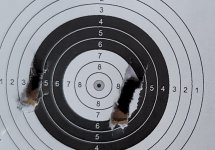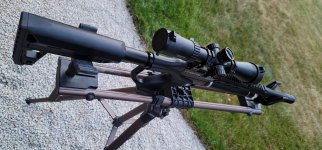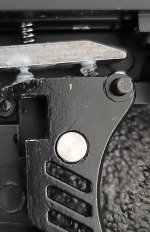After about 2 months of waiting, my first foray into pcp is underway via the Umarex Notos CRK.
Goal was a backyard friendly and cheaper than powder burning fun experience.
After about 100 rounds of 15.89 Hades and figuring out the West Hunter scope, I am getting a feel for the Notos.
The concrete slab behind the target is the loudest sound. The West Hunter optics and mount work well. The 3D printed insert is excellent.
And this gun is more accurate than I am at the moment.
31 yard 5 shot grouping - there was a good gust of right to left wind, but that shot to the left was most likely me.

I hope to pop this Notos open and adjust the trigger to be lighter. Carm mags and a gauge block were ordered because, why not!
Appreciate everyone sharing their experiences here. Allowed me to make an informed decision, a happy purchase, and happy 3D print. Goals met.
Shooting from this platform that is very old, but does the trick.

Goal was a backyard friendly and cheaper than powder burning fun experience.
After about 100 rounds of 15.89 Hades and figuring out the West Hunter scope, I am getting a feel for the Notos.
The concrete slab behind the target is the loudest sound. The West Hunter optics and mount work well. The 3D printed insert is excellent.
And this gun is more accurate than I am at the moment.
31 yard 5 shot grouping - there was a good gust of right to left wind, but that shot to the left was most likely me.

I hope to pop this Notos open and adjust the trigger to be lighter. Carm mags and a gauge block were ordered because, why not!
Appreciate everyone sharing their experiences here. Allowed me to make an informed decision, a happy purchase, and happy 3D print. Goals met.
Shooting from this platform that is very old, but does the trick.


